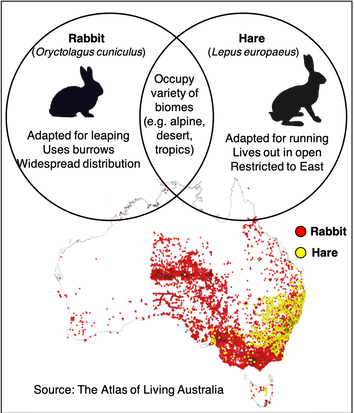My research interests lie in understanding Biodiversity, asking how the great diversity in animal forms came about under the influence of various evolutionary processes.
As a research scholar, I have contributed to our basic understanding of biodiversity, by describing new species, revising taxonomy, and assessing distributions diversity (see Publications). But my main research focus is in Macroevolution - to identify the patterns and infer processes underlying morphological diversity, by choosing biologically diverse systems and formulating research hypotheses that can be tested quantitatively.
In general, I apply a suite of statistical tools to measure variation in form, specifically size and shape of morphological structures, within a comparative framework. Predominantly, I use X-Ray Micro Computed Tomography and surface scanning technology to gather three-dimensional representations of an organism's anatomy, and traditional and geometric morphometrics to quantify and study variation in morphological traits.
To date I have studied a variety of organisms including rabbits and hares (Lagomorpha), scallops (Pectinidae), Anolis lizards, caecilian amphibians (Gymnophiona), snakes, and laboratory mice.
As a research scholar, I have contributed to our basic understanding of biodiversity, by describing new species, revising taxonomy, and assessing distributions diversity (see Publications). But my main research focus is in Macroevolution - to identify the patterns and infer processes underlying morphological diversity, by choosing biologically diverse systems and formulating research hypotheses that can be tested quantitatively.
In general, I apply a suite of statistical tools to measure variation in form, specifically size and shape of morphological structures, within a comparative framework. Predominantly, I use X-Ray Micro Computed Tomography and surface scanning technology to gather three-dimensional representations of an organism's anatomy, and traditional and geometric morphometrics to quantify and study variation in morphological traits.
To date I have studied a variety of organisms including rabbits and hares (Lagomorpha), scallops (Pectinidae), Anolis lizards, caecilian amphibians (Gymnophiona), snakes, and laboratory mice.
Current Research
Adaptive Morphology and Evolution of Invasive Rabbits and Hares
|
Invasive species are an excellent system with which to answer key questions in evolutionary biology. Australia is unfortunately home to many invasive species, including rabbits and hares. Given that invasive species pose great economic and environmental costs to Australia, with rabbits alone costing an estimated $206 million per year to agriculture and horticulture, it is imperative that we better understand how these animals are changing and adapting on our continent.
My Australian Research Council (ARC) Funded Future Fellowship (FT190100803) project aims to uncover the morphological variation that allows rapid adaptive evolution in two invasive species, the rabbit and hare. This project expects to generate new knowledge at the interface between invasion biology and evolutionary biology, using cutting-edge methods to phenotype widespread populations. This project will address key inter-related hypotheses of rapid adaptive evolution at temporal, spatial and phylogenetic scales, particularly about changing morphologies involved role in locomotion and dispersal ability. Expected outcomes of this project include a comprehensive phenotypic database of these two species and identifying how these invasive species are adapting to the Australian landscape. |
Macroevolution of Australian elapid snakes
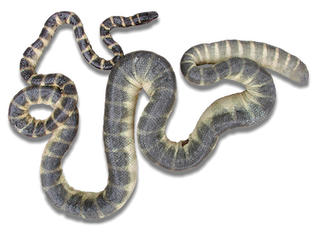
Australia is home to many such radiations of reptiles, including highly-venomous snakes, Elapidae. Comprising ~160 species, they have radiated into a wide range of ecosystems (both terrestrial and marine) and a variety of dietary specialists. Australia’s elapids are a unique model system to answer fundamental questions in evolutionary biology.
You can read the article on trophic specialisation in sea snakes in Royal Society Open Science, two articles on vertebral evolution and development of the sea snake body in Evolution & Development 2019a & 2019b, and the article on evolution of the tiny heads of microcephalic sea snakes in Integrative and Comparative Biology.
This research began as a University Research Fellowship (2017-2019) at the University of Adelaide, working with Kate Sanders (University of Adelaide), Mike Lee (Flinders University) and Alessandro Palci (Flinders University). This project has evolved and is continuing under the funding of Australian Research Council (ARC) Funded Discovery Project (DP200102328) Snake fangs: insights into evolution, palaeoclimate and biodesign with Mike Lee (Flinders University) and Alessandro Palci (Flinders University).
This project aims to generate unprecedented insights into the fangs of venomous snakes, focusing on elapids (taipans, tiger snakes etc). We will examine fang shape diversity, correlation with behavior and ecology, evolutionary history, and biomechanical properties. Data will be collected using cutting-edge micro-CT technology and analysed using 3D geometric morphometrics, computer simulations, and advanced phylogenetic techniques. This should greatly improve understanding of the evolution of venom fangs in all snakes. Other benefits include a large 3D reference database allowing identification of fossil fangs, with applications for studies of past climates, and a characterisation of fang biomechanics, relevant to biodesign and biomimicry.
You can read the article on trophic specialisation in sea snakes in Royal Society Open Science, two articles on vertebral evolution and development of the sea snake body in Evolution & Development 2019a & 2019b, and the article on evolution of the tiny heads of microcephalic sea snakes in Integrative and Comparative Biology.
This research began as a University Research Fellowship (2017-2019) at the University of Adelaide, working with Kate Sanders (University of Adelaide), Mike Lee (Flinders University) and Alessandro Palci (Flinders University). This project has evolved and is continuing under the funding of Australian Research Council (ARC) Funded Discovery Project (DP200102328) Snake fangs: insights into evolution, palaeoclimate and biodesign with Mike Lee (Flinders University) and Alessandro Palci (Flinders University).
This project aims to generate unprecedented insights into the fangs of venomous snakes, focusing on elapids (taipans, tiger snakes etc). We will examine fang shape diversity, correlation with behavior and ecology, evolutionary history, and biomechanical properties. Data will be collected using cutting-edge micro-CT technology and analysed using 3D geometric morphometrics, computer simulations, and advanced phylogenetic techniques. This should greatly improve understanding of the evolution of venom fangs in all snakes. Other benefits include a large 3D reference database allowing identification of fossil fangs, with applications for studies of past climates, and a characterisation of fang biomechanics, relevant to biodesign and biomimicry.
Past Research Topics
Ecomorphological diversity of Australia's larval Frogs

Tadpoles are the free-living aquatic larval stage of frogs and toads. Australia is home to 244 species of frogs, and around 200 of those have a free-living larval stage that is aquatic, or has some terrestrial development in moist burrows. I am using the comprehensive work "Tadpoles and frogs of Australia" by Marion Anstis to study macroevolutionary patterns of tadpoles and their adult frogs, and understand the ecomorpholgical diversity of Australia's tadpoles.
This research was with J. Scott Keogh at Australian National University and Marion Anstis of University of Newcastle, Australia.
Check out the publication on the disconcerted evolution of adult frogs and their tadpoles in Nature Ecology & Evolution. And the publication on ecomorphological diversity of tadpoles in Ecology and Evolution.
This research was with J. Scott Keogh at Australian National University and Marion Anstis of University of Newcastle, Australia.
Check out the publication on the disconcerted evolution of adult frogs and their tadpoles in Nature Ecology & Evolution. And the publication on ecomorphological diversity of tadpoles in Ecology and Evolution.
Tempo and Mode of Evolution in Scallops
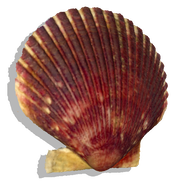
The tempo (rate) and mode (process) or Evolution has long been a source of question and debate in biology. My research in this area focusses on the tempo and mode of Evolution at a broad (macro-) evolutionary scale, i.e across many species, in bivalved scallops (Pectinidae).
We have identified that scallop shell shape is influenced by life habit. This research was with Dean C. Adams and Jeanne Serb at Iowa State University.
You can read the first article about directional evolution in recessing scallop species in Evolution
And the second article about convergent evolution of gliding scallop species in Journal of Evolutionary Biology
And the final article about rates of morphological evolution and integration in BMC Evolutionary Biology
We have identified that scallop shell shape is influenced by life habit. This research was with Dean C. Adams and Jeanne Serb at Iowa State University.
You can read the first article about directional evolution in recessing scallop species in Evolution
And the second article about convergent evolution of gliding scallop species in Journal of Evolutionary Biology
And the final article about rates of morphological evolution and integration in BMC Evolutionary Biology
Anolis lizard evolution thru' the eye of amber fossils
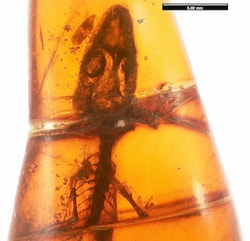
Anoles are a model system for evolutionary research. To date, a great deal has been learnt about the convergent evolution and multiple radiations of this group (see the Anole Annals page for more details). Phylogenetic trees from molecular data have given us a peek into the evolutionary history of the group.
The purpose of my research was to add a fossil component to the Caribbean Anolis diversification story, using amber preserved fossils from the Dominican Republic. To date, three specimens have been published upon: Rieppel 1980, De Queiroz et al. 1998, and Polcyn et al. 2002. Using these and a number of unpublished specimens, I have added to our knowledge of the evolutionary history of anoles by building a picture of the anole community composition at 20MYA, a point halfway through the predicted age of the radiation. You can read more about this project here and here.
Articles on this research are published in PNAS and ZOJ.
The purpose of my research was to add a fossil component to the Caribbean Anolis diversification story, using amber preserved fossils from the Dominican Republic. To date, three specimens have been published upon: Rieppel 1980, De Queiroz et al. 1998, and Polcyn et al. 2002. Using these and a number of unpublished specimens, I have added to our knowledge of the evolutionary history of anoles by building a picture of the anole community composition at 20MYA, a point halfway through the predicted age of the radiation. You can read more about this project here and here.
Articles on this research are published in PNAS and ZOJ.
Evolution of the Caecilian Skull
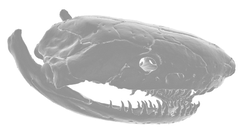
A rare and uncommon group of vertebrates are caecilians, limbless amphibians distantly related to frogs and salamanders. I studied caecilians because they have fascinating skulls, quite unlike their superficial vertebrate cousins -snakes- and far more similar to extinct early tetrapods. They are cryptic and most are burrowing specialists. Though despite efforts by keen herpetologists, they remain relatively understudied. Extensive fieldwork done by Dr Mark Wilkinson, Dr David Gower and their colleagues has provided the Natural History Museum London UK with the largest collection of caecilians in the world. I spent over 160 scanning hours to collect micro CT scans of 615 caecilian specimens, around 150 species. From these scans I examined cranial evolution of caecilians, using geometric morphometrics. We also used the micro CT scans to help with taxonomic character identification. Articles on this research include those published in Evolutionary Biology and Zootaxa.
These data were subsequently used to support student research projects on morphological integration and modularity in the caecilian skull published in BMC Evolutionary Biology and Biological Journal of the Linnean Society.
These data were subsequently used to support student research projects on morphological integration and modularity in the caecilian skull published in BMC Evolutionary Biology and Biological Journal of the Linnean Society.
